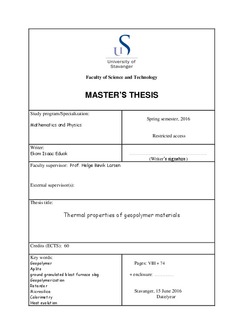| dc.contributor.author | Eduok, Ekom | |
| dc.date.accessioned | 2016-09-12T08:04:00Z | |
| dc.date.available | 2016-09-12T08:04:00Z | |
| dc.date.issued | 2016-06-15 | |
| dc.identifier.uri | http://hdl.handle.net/11250/2406053 | |
| dc.description | Master's thesis in Mathematics and Physics | nb_NO |
| dc.description.abstract | Ordinary Portland cement (OPC) is traditionally the most common binder in concrete manufacturing and is widely used in the petroleum industry, yet its mechanical properties have some shortcomings and its production has proven environmentally harmful. In addition, various industries generate by-products which also have a negative environmental impact. Interested parties therefore seek to replace OPC with a superior cementitious material that can be produced through recycling industrial by-products. One potential replacement is geopolymer binders; however, the quality of the geopolymer depends on the source materials used and the specific methods for creating it.
Ground granulated blast furnace slag (GGBFS) is a by-product of iron or steel manufacturing. This research conducts a thermal analysis on the creation of an aplite-slag (GGBFS) based geopolymer, considering the effects of 1) the addition of microsilica to increase the silica/alumina ratio, and 2) the addition of sucrose as a retarder to shift the geopolymer setting time. The results indicate that increasing the soluble silicate content has a negative effect, but an optimal curing temperature tends to improve the extent of geopolymerization. Additionally, an optimum retarder dosage of sucrose was found to be 1.2% of the total solid content, which lengthened the geopolymerization process by 20.39 minutes and also increased the heat evolution by 13.3%. These adjustments would lead to better physical and mechanical properties in the final product, thus presenting an encouraging prospect in the industrial application of this material. | nb_NO |
| dc.language.iso | eng | nb_NO |
| dc.publisher | University of Stavanger, Norway | nb_NO |
| dc.relation.ispartofseries | Masteroppgave/UIS-TN-IMN/2016; | |
| dc.rights | Navngivelse-Ikkekommersiell-IngenBearbeidelse 3.0 Norge | * |
| dc.rights.uri | http://creativecommons.org/licenses/by-nc-nd/3.0/no/ | * |
| dc.subject | geopolymer | nb_NO |
| dc.subject | aplite | nb_NO |
| dc.subject | ground granulated blast furnace slag | nb_NO |
| dc.subject | geopolymerization | nb_NO |
| dc.subject | retarder | nb_NO |
| dc.subject | microsilica | nb_NO |
| dc.subject | calorimetry | nb_NO |
| dc.subject | heat evolution | nb_NO |
| dc.title | Thermal properties of geopolymer materials | nb_NO |
| dc.type | Master thesis | nb_NO |
| dc.subject.nsi | VDP::Mathematics and natural science: 400::Physics: 430 | nb_NO |

